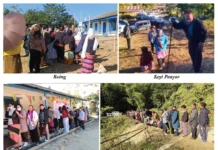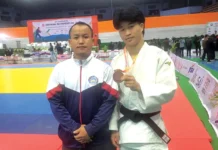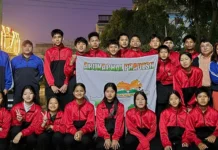Rono Hills ready for XXI convocation
RONO HILLS, 29 Nov: Rajiv Gandhi University (RGU) here is not only one of the pioneer institutes of the state but also of the entire Northeast region of the nation.
The year 1997-’98 witnessed the first-ever convocation ceremony of the university. Since then, the university has been organising the convocation ceremony from time to time. However, beginning as a state university in 1984, RGU as a distinguished central university now holds its convocation each year on 30 November. This in itself indicates commitment, conviction and confidence in the work culture of the university.
This year the university is organising its 21st convocation on 30 November at RGU, in which there are 7,403 awardees of degrees comprising 120 doctoral degree holders, 28 MPhil, 969 postgraduates and 6,186 undergraduates. In an unprecedented 120 PhD awardees, there are 43 male and 77 female candidates. The number of the total PhD awardees has enhanced exponentially over the past five years and it has risen to 400 per cent over these years. Also, the percentage of female students securing UG gold medals are more than double (21 females, 9 males) and the proportion for PG gold medallists continues to be on the higher side in favour of women (24 females and 14 males).
The 82 per cent pass percent of undergraduates and over 62 per cent for postgraduate candidates are equally worth noting.
The event is scheduled to be attended by Governor of Arunachal and Chief Rector of RGU, KT Parnaik, while retired IAS officer and RGU Chancellor Dr J Suresh Babu will preside over the session. Both of them will be attending the event for the first time as new appointees to the respective positions.
The convocation address is to be delivered on the theme, ‘Bharatiya gyan parampara and the essence of higher education’ by Prof GD Sharma, leading educationist, eminent scholar, reputed life scientist and well-known academic administrator, who is also the president of the Association of Indian Universities (AIU), New Delhi, and the Vice Chancellor of the University of Science & Technology, Meghalaya.
RGU Registrar Dr NT Rikam, Controller of Examinations Dr Bijay Raji, Finance Officer Prof Otem Padung, distinguished members of the university court, the academic council, and the executive council, deans of faculties, heads of departments, directors of institutes, statutory officers, faculty members, staff, students comprising awardees of medals and degrees and their family members are to attend the event.
A brief account of past few convocations of RGU
The 15th convocation of RGU was organised in 2017. The occasion was graced by Governor BD Mishra, in which 39 PhD degrees, 20 MPhil degrees and 23 gold medals were awarded. Out of 6,151 undergraduates and postgraduates, 1,003 candidates were conferred their degrees in person in the 15th convocation of the university.
The 16th convocation of RGU was held on 30 November, 2018. About 1,000 candidates participated and received their respective degrees. a total of 5,867 students were conferred degrees for various courses, which includes 44 PhDs, 29 MPhils 1,398 postgraduate and 4,396 undergraduate degrees. In addition to this, a total of 51 gold medals were awarded – 1 Chancellor’s Gold Medal for the topper amongst postgraduates, 2 Vice Chancellor’s Gold Medals for the topper from amongst undergraduates and 25 gold medals for postgraduate and 23 for undergraduate courses for best performance among the first class division holders in each subject.
The 17th convocation of RGU was held on 30 November, 2019, in which the female students took away the highest number of gold medals in their respective disciplines. two students received the coveted Chancellor’s Gold Medal and one Vice Chancellor’s Gold Medal for the 2018-’19 academic session. The medals were presented by Governor BD Mishra. Twenty-five students received gold medals in various degrees, while 27 graduates from various colleges under RGU were awarded gold medals in their respective disciplines. Along with Mishra, Tezpur University Vice Chancellor Prof Vinod Kumar Jain graced the event.
RGU hosted its 18th convocation on 30 November, 2020 on its campus at Rono Hills amid strict adherence to Covid-19 protocols issued by the central and the state governments. Governor BD Mishra delivered the presidential address, while union Education Minister Ramesh Pokhriyal ‘Nishank’ delivered the convocation address. The then union MoS for Youth Affairs & Sports Kiren Rijiju had also attended the event and addressed the convocation. A maximum of 200 people was allowed in the university’s 1,000-seat convention hall for the convocation. They included members of the university’s court, comprising those in RGU’s executive council, academic council, deans and heads of departments. In all, 6,712 students, including 39 PhD scholars, 66 MPhil scholars, 572 students in postgraduate and 6,035 students in undergraduate courses were conferred degrees at this convocation. Among them were 52 gold medallists, including 25 in graduation, 24 in postgraduation and one in MPhil, besides the recipients of the VC’s Medal awarded to the overall topper of the undergraduate courses and the Chancellor’s Medal awarded to the PG topper.
RGU conducted its 19th convocation in a row on 30 November, 2021 in the blended mode. The university has a unique practice of conducting the annual convocation on a fixed date every year. In the convocation, a total of 7,664 students, comprising PhD (33), MPhil (6), PG (913) and UG (6,712) degrees were conferred with degrees. The gold medallist, PhD and MPhil students received the degree physically while rest of the students, including UG and PG, were awarded degrees in the virtual mode via Google Meet. Governor Mishra presided over the convocation. Former NCERT director Jagmohan Singh Rajput delivered the convocation address, while state Education Minister Taba Tedir addressed the gathering.
The 20th convocation of RGU was held on 30 November, 2022, and Governor Mishra stressed the need for concerted effort by students and faculty to give RGU a pan-India character. A total of 6,352 students graduated in the academic session 2021-’22 and were conferred degrees during the convocation, which included 62 PhDs, 56 MPhil, 947 postgraduation and 5,405 undergraduate degrees. Earlier, the governor laid a wreath at the ‘Wall of Heroes’ installed at the amphitheatre of the university. The Wall of Heroes, an initiative of the Vidya-Veerata Abhiyan under the aegis of the human resource development ministry, pays homage to war heroes conferred with the Param Vir Chakra.
The foundation stone of the present RGU, which was laid by the then prime minister Indira Gandhi on 4 February, 1984, in the presence of the then chief minister Gegong Apang and PK Thungon, still bears testimony to the fact that the original name of the present RGU was Arunachal University, which was a complete address in itself. Detailed below is a glimpse of the evolutionary journey of RGU, which is inspired and based on the developmental milestones of RGU published in The Arunachal Times on its 37th foundation day by Prof Tomo Riba, former registrar of RGU and present vice chancellor of Arunachal Pradesh University.
Historical inception of RGU
Four years were needed to establish the basic infrastructure in Rono Hills. Prior to moving to the current campus, the BEd programme was taught in Itanagar, in a barrack building intended for a night college, close to the current government higher secondary school, Itanagar. Answer scripts were sent to Chandigarh for assessment. The political science and history departments were established in Pasighat. After the purchase of the present campus from four villages, a few basic infrastructures were developed, and in 1988-99, those three departments were shifted to Rono Hills. The first vice chancellor of the university was Professor CL Anand.
During those days, life in the campus was completely different. It was a paradise for deputed teachers for BEd course. Though hunting and fishing were out of syllabus, they were given maximum time. Along with pens, a few deputed teachers had also brought guns with them. Animals like barking deer, monkeys, civets and wild fowl were hunted. Dried skins of deer with hair were presented to teachers as decoration items.
To reach the campus was very much arduous. Commuter employees from Itanagar and Naharlagun had to make big round via Harmuty, with an extra distance of around 30 kms. There was also a boat to ferry people across the Dikrong river, which was perilous during monsoon. Sometimes the current of the water was much stronger than the arms of the boatmen, and boats were carried away further down the stream with wailing passengers in it.
Era of the hanging bridge (1994)
Then, in 1994, a swing bridge on metal wire was built to span the river, putting drivers’ driving prowess to the test. We were unable to see rickshaws approaching from either end of the bridge, since the central section was elevated. At times, a gathering of two or more rickshaws would occur in the middle of the bridge. It was difficult to push back the rickshaws on the tiny bridge and the weaker passengers had to recede.
University vehicle fleet evolution
The approaching hanging bridge attracted a lot of people who decided to purchase Bajaj Super or Chetak scooters. The university had a white Ambassador for the VC and a 407 mini-bus. Later on, a white Gypsy and a dark-green van were purchased for the registrar and the CoE. We were proud to have those four vehicles. Now, RGU has more than 10 buses, a truck, and tankers for lifting water, two ambulances and a good number of small official vehicles. Pre-primary school was run in a Type V quarters.
Elephant dominance in the 1990s
Elephants outnumbered students on campus in the early 1990s. During construction time, elephants would come at night and damage the construction work. One night, an elephant sneaked into the store of the school and ate up the whole newly-collected chalks.
During daytime, students and employees used to play in the present playground, and at night elephants used it. We remained confined to the southern tip of the campus and maximum part of the present campus was occupied by elephants.
The present Subansiri Halls of Residence was enough to accommodate all the students. The present old auditorium was sufficient to accommodate all the students of the university during examinations.
Today, RGU has 12 hostels, but only 50 per cent students can be accommodated. Changes were very slow in the beginning, but it picked its momentum; many changes have come in the university.
Introduction of the first computer (1995)
The first computer arrived in 1995 at RGU. For us, it was an expensive and uncommon object. Seldom was it allowed to be touched. It was placed in a designated chamber for protection, particularly against viruses. The computer room was off-limits to shoe use and even loud conversations. We had to wait a few minutes in silence while we discreetly observed the printer, its head moving slowly to the left and right, and the paper coming out of the tray slowly.
Before, there was only the sound of the printer’s head and roller, which sounded like they were counting each word. E-waste has grown to be another issue for RGU these days.
During 2004-2006, there was a movement initiated by the Arunachal University Teachers’ Association (AUTA) for conversion to central university, where Prof Tana Showren played a great role in influencing the favour of Rajya Sabha member Nabam Rebia, who was also the general secretary of the MP Forum of North East Region. He got the signatures of all the MPs of the Northeast region in favour of conversion of the state university into a central university.
When almost all the processes were over, and the Centre in its national policy decided to create one central university in all the states of the Northeast region, the name of Arunachal University was changed to Rajiv Gandhi University. That made us feel a sense of loss of identity, and we protested. Our protests were never heard. Finally, RGU was converted into a central university on 9 April, 2007, with continued use of the old logo.
Contributions of our former VC’s
The contributions of formers vice chancellors like Prof CL Anand, Madan Jha, Raghunathan, Prof AC Bagabati, Dr KK Dwivedi, Prof SC Jha, Prof KC Belliappa, Prof Atul Sarma, Prof David R Syiemlieh and Prof Tamo Mibang stand documented in golden letters in the evolutionary journey of RGU.
Prof Tamo Mibang was the longest serving VC of the university. Dr Joram Begi and Dr Tai Nyori also contributed much in making this university. Dr Begi served this university as a registrar for 10 years. Dr Tai Nyori served this university as controller of examinations for 17 years, and as a registrar for six years.
The recent developments
Prof Saket Kushwaha is the present vice chancellor of the university. RGU, the easternmost located and a relatively younger central university, has left behind many central universities in the race of academic achievements. It has bagged the second rank in the country among the universities as per rating of the UGC and the union education ministry in one of its rankings in 2020.
Based on the performance of the universities during the Covid-19 pandemic period, RGU has been rated the best university among the Himalayan universities.
Today, RGU runs more than 100 academic programmes, including PG programmes, undergraduate courses, diploma courses, certificate courses, including PhD and MPhil. Under RGU, there are 45 affiliated colleges, both government and private. The number of departments has nearly doubled in past few years, reaching 44 currently.
The following are the few uniqueness of RGU. The Arunachal Institute of Tribal Studies is actively devoted to documentation and publication of tribal culture. The department of zoology has identified many new fish species of Arunachal Pradesh. Most of the major traditional festivals of the state along with the festivals of the country are celebrated in the campus by the students and employees. University Festival, University Panorama and Inter-College Youth Festival are organised, where along with the games and sports, the culture of the tribes are displayed, including house pattern, traditional attires and traditional foods, folk songs, and dances.
RGU continues to stand tall on its standards of accountability and transparency with suo moto disclosure of information under transparency audit. RGU has further augmented its records under suo moto disclosure of information under transparency audit. Like past few years, this year too, RGU has secured over 95 per cent marks in its third-party transparency audit report by an independent reviewer.
The convocation, admission, examination, and results announcement in accordance with the calendar are examples of RGU’s exemplary practices. The existence of a campus community is another distinctive feature of RGU. Most instructors, students, and staff members who are not educators reside on campus. Total Number of departments has risen to double in past five years and number of courses being offered has risen in the same proportion. Number of total students’ intake have also risen to nearly double (100 per cent) in past five years. The university continues to maintain male-female ratio of learners in equal proportions with those from socio-educationally and economically weaker sections constituting nearly 90 per cent of the total strength. 70 per cent of the gold medallists of the university have been female candidates.
RGU has established the Centre for Buddhist Studies with a corpus of Rs 5 crore supported by the state government. RGU has secured the 16th rank (overall) among the central universities across the nation in the Indian Institutional Ranking Framework. International Centre of Excellence in Millets Research has been established in the campus this year.
In our endeavours to implement the path-breaking and revolutionary features of National Education Policy-2020, we have generated academic bank of credit (ABC) ID for nearly all (99 per cent) of our learners. RGU has implemented four-year integrated BA, Bed after being selected by the ministry of education, government of India. Four-year undergraduate programmes (FYUP) in sciences and social sciences (BA and BSc, respectively) with multiple entry and exit system have been implemented in the university.
In order to facilitate the quality implementation of FYUP under NEP-2020, the Institute of Under Graduate Studies has been established in the campus.
All 18 key mandates for higher educational institutions under NEP-2020 have been implemented at RGU with students’ portability across institutions within the state of Arunachal Pradesh being a rare feat across country. All the 45 affiliated colleges of the university have been enabled with the course curriculum and have been subsequently mandated with FYUP from current academic year 2023-24 under the vision and guidelines of NEP-2020.
With perseverance and a positive outlook, RGU would advance towards academic success. Despite being a central university, the state government has made significant contributions to the growth of RGU by providing adequate power, water, and road connectivity as well as a few notable buildings. It is equally a matter of pride for entire RGU fraternity to learn that the state government has provided free of cost land of 500 acres across three different locations in Arunachal Pradesh for the campus expansion of Rajiv Gandhi University. It is all set to contribute to NEP-2020 vision of Campus Aapke Dwar.
Moreover, water plant, student activity centre, rostrum, auditorium furniture, high-mast buses have been provided by the state government through Rs 50-crore support money.



